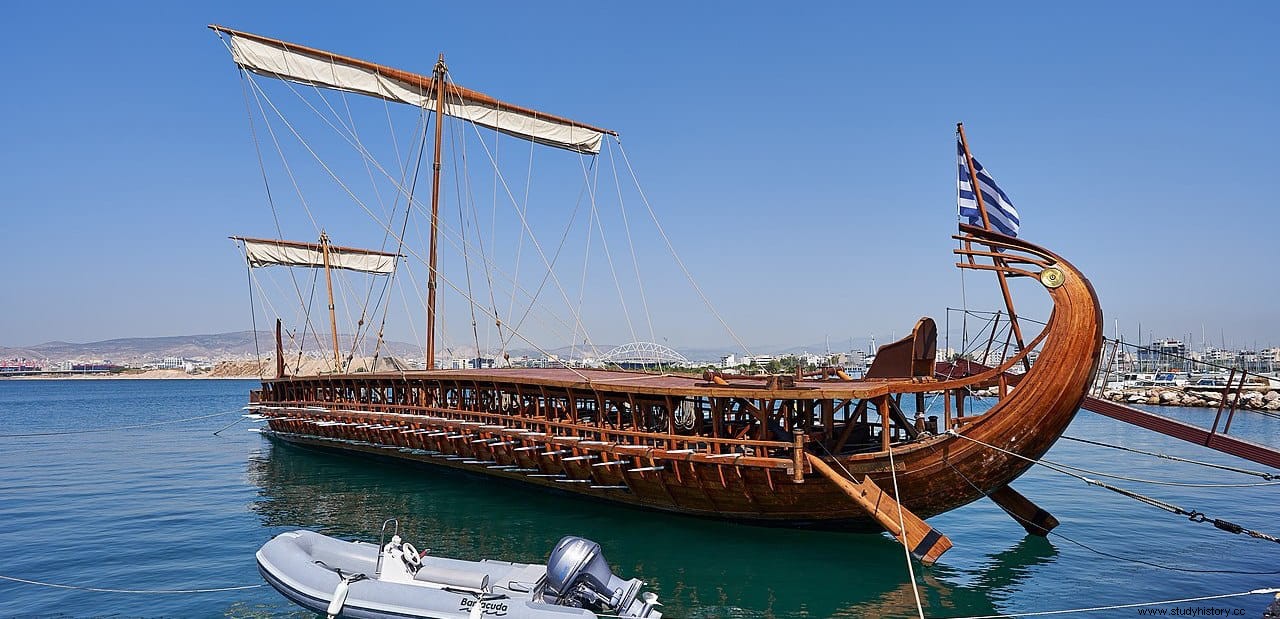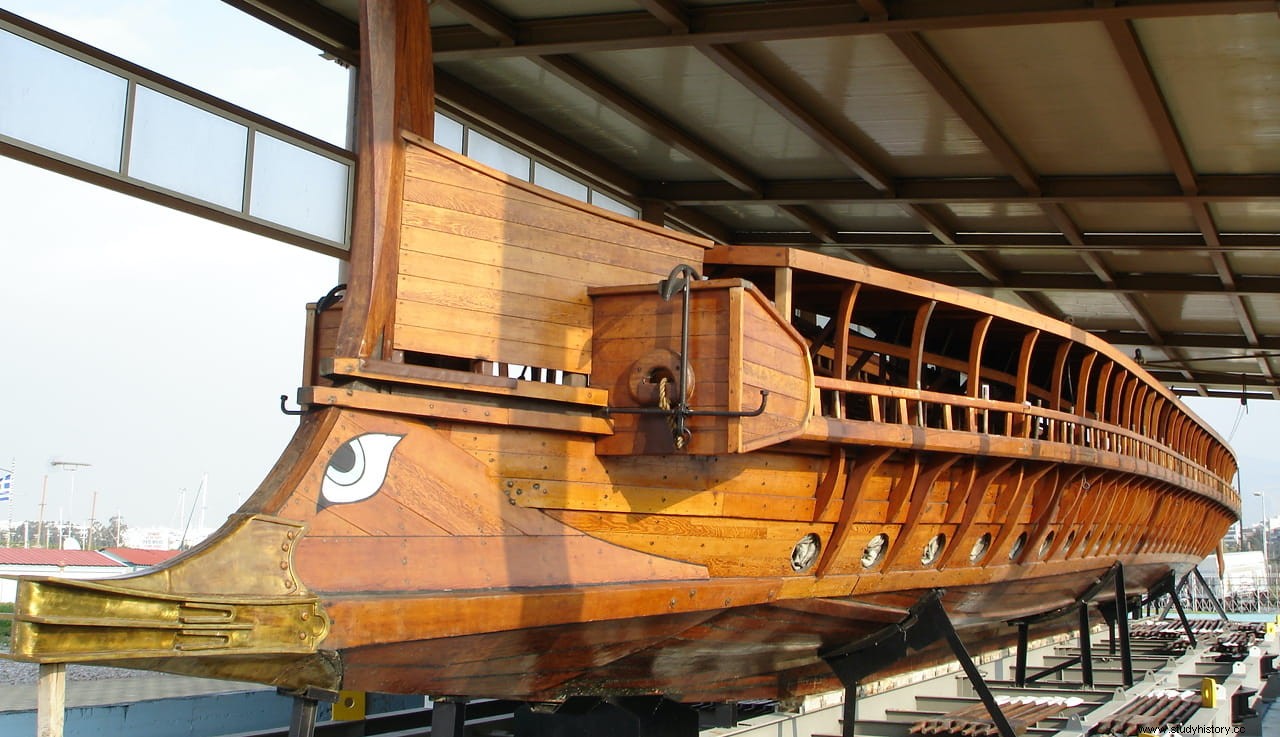If we talk about a warship called Olympias that it is a trireme and that it was built in Piraeus, the port of Athens, it is inevitable to think of Themistocles' fleet, for example.
The stratego The Athenian naval force was covered in glory at the Battle of Salamis against Xerxes' Persian squadron, with the triremes playing the leading role. However, the Olympias it was launched in 1987 and is part of the Hellenic Navy, Greece's naval force. Of course, it is not that the crisis has led the Greek military to have to recover designs from Antiquity, although in fact it is something unique in the world:it is a real-size reconstruction of an ancient Athenian trireme, a way of paying homage to that weapon that guaranteed the independence of the city-state and of the entire Helladic continental territory, in addition to providing it with wealth and power and serving as a model for naval engineering for several centuries.
As the word indicates, a trireme was a boat that sailed propelled by three rows of oars in each band. Evolution of the previous bireme -in turn based on the pentecontera of fifty oarsmen- and antecedent of the colossal quadriremes and subsequent quinqueremes, had made an appearance in the seas at the end of the 7th century BC , if we pay attention to Herodotus when he tells that the channel excavated by Pharaoh Necao to communicate the Nile with the Red Sea had a width of two triremes. It is difficult to establish who its inventors were; some point toCorinth , others toSamos . In any case, the Aegean was soon filled with them and not only by the Greeks, because the Persians also used them.

Despite its size and being moved by human power, the trireme was quitefast , something fundamental because his combat technique was based on ramming the enemy ship with the bow spur. For that reason it also had to be very solid, which was achieved by the so-called hypozoma :a thick rope, pre-tensioned by means of a windlass, which ran the length from the stem to the stern, keeping the frames tight and providing solidity to the hull; after each trip it was customary to beach the ship to tighten the ropes again.
The trireme could reach a speed of 16 knots , carrying a crew of two hundred men :the trierarch (financial officer of the trireme, could also be the captain), the kibernet (helmsman), the proreus (fore officer), the keleuste (boatswain), the pentekontarchos (intendent), an aulet (flautist musician who set the rhythm of the vogue), a dozen seamen gavieros, 14 epibatas (soldiers, of which 10 were hoplites and 4 archers) and 170 eretai (rowers). The latter, who at first were free citizens who were paid for their work, were distributed in three rows of benches from bottom to top:54 talamites , 54 zigitas and 62 tranitas . The lowest row was half a meter above the waterline, the middle row was above the beams, and the highest row was outside the hull, on an exterior structure, to avoid having to raise the gunwale too high.
As for the Olympias, it was designed by the (now deceased) British naval engineer John Francis Coates , specializing in ancient ships, with the advice of the historian John Sinclair Morrison , an expert on Classical Greece, and Charles Willink , another specialist in that Greek period. To tackle the work they based themselves on texts of the time, artistic images and, above all, archaeological remains. Thus, with the financial support of the Hellenic Navy and the collaboration of the banker and writer Frank Walsh enthusiastic about the idea, they founded the Trireme Trust to begin construction, which took place over a little over two years, between 1985 and 1987.

wood was used Oregon pine and Virginia oak, in addition to the iroko used for the keel. For the spur, made of bronze (200 kilos weighs), one preserved in the Archaeological Museum of Piraeus was taken as a model. Not all the pieces could be made with the technique of yesteryear; For the hypozome, for example, no suitable fibers were found to guarantee the safety of the ship, so steel cables were chosen instead. . That, together with the curious detail that the average height of rowers is 20 centimeters higher than before, increased the weight of the Olimpias , so in the successive navigation tests it could not reach 16 knots and stayed at 9 , although it was maneuverable enough to turn 180 degrees in a minute , for example.
The ship measures 40 meters length by 5.5 sleeve and 1.25 draft, being also provided with a pair of masts for sailing. Bearing in mind that the volunteers who formed the crew for these experimental voyages were not as trained as those of ancient times, the results were satisfactory and indicated that the descriptions of the extraordinary capacity of the triremes left by ancient authors, such as Thucydides, were not exaggerated at all.
The Olympias he participated in various official events, including the transportation of the Olympic torch from Keratsini to Piraeus for the 2004 Olympic Games. Of course, there never was and never will be the chance to see him in combat, but you can squint a little and imagine him in the Salamis bay as part of that metaphorical wooden wall that the fortune-teller advised Themistocles to build, surrounded by burning Persian ships unable to take advantage of her numerical superiority by hindering each other. Then when we open our eyelids, we will see the last trireme in a dry dock of the Traditional Navigation Park of the coastal neighborhood of Palaio Faliro (Athens), where it is exhibited to the public. Although the ship is no longer sailing, it is still commissioned, that is, it is considered active within the Greek navy.
